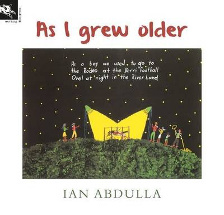As I Grew Older by Ian Abdulla

Working Title Press, 2014. ISBN 9781921504693.
Highly recommended. Picture book. As I Grew Older
(first published in 1993 and recently republished in paperback by
Working Title Press) is a moving pictorial introduction to the life
of an Aboriginal family living along the River Murray during the
1950s and 60s. Ian Abdulla's wonderful paintings and simple text
descriptions record both the everyday activities and also special
events that were keenly anticipated all year, such as the night
rodeo held on Berri oval. The enchanting illustration of the rodeo,
my favourite in the book, has two cones of light illuminating a
daring bare-back rider and watched by an enthusiastic audience, both
brown and white skinned. Twinkling stars in a cloudless sky form a
backdrop to all. Other favourite childhood activities that are
lovingly recorded here are playing 'chicken' on the ferry going to
school, and cowboys and Indians, played using the materials to hand:
the jaw-bone of a sheep in place of a gun and a gum tree branch for
a horse.
But it is the River Murray that is the real star of this book.
Patiently winding its way through across the pages, the river
provides sustenance for the Abdulla family, giving them food,
income, shelter and entertainment through times that were hard for
everyone - but especially hard for Aboriginal people. There is a
strong sense that this family is completely at home on and in the
river and with the flora and fauna on its banks. The end-page of the
book helpfully provides a map of the district between
Kingston-on-Murray and Berri that helps to trace the Abdulla
family's movements as they catch fish, collect swans' eggs, and pick
grapes to make a living. The map also pinpoints the location of the
Gerard Mission, where Ian Abdulla is today buried alongside family
members.
As I Grew Older does not directly talk about the policies
towards Aboriginal people at the time Abdulla was growing up in the
Riverland, but much can be inferred from the family's need to draw
so heavily on the resources of the river. As I Grow Older is
as quietly instructive for an adult audience as for children.
Teachers can use this book to consider changes that occurred in the
Riverland area in the century after white settlement and the extent
to which the Ngarrendjeri people were able to maintain their
connections with land and river. It is wonderful that the
republishing of this important book affords an opportunity to
introduce this important South Australian artist to a new
generation.
Francine Smith